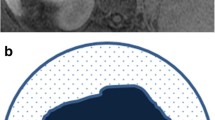Abstract
Purpose
To analyze Gd-EOB-DTPA-enhanced magnetic resonance (MR) findings of nodules (low-grade dysplastic nodules—LGDNs; high-grade dysplastic nodules—HGDN, and hepatocellular carcinoma—HCC), histologically identified on cirrhotic, explanted livers.
Methods
IRB approval was obtained for this study. Thirty-four patients underwent Gd-EOB-DTPA-enhanced MR examinations (1.5T system), that included 20-min delayed hepatobiliary (HB) phase imaging, before undergoing orthotopic liver transplantation (OLT; mean time MR-OLT: 2.7 months). A total of 102 hepatic nodules were identified and analyzed at histopathological examination, and classified as LGDN, HGDN, and HCC. Two radiologists by consensus performed a quantitative (enhancement ratios, ERs) and a qualitative analyses of signal intensities of identified nodules on vascular dynamic phases (30–35 s after injection–arterial phase; 180–190 s after injection late phase) and on HB phases. Correlation between nodules MR patterns and histological classification was analyzed by means of dedicated statistical software.
Results
No differences were appreciable among ERs of HGDN and HCCs on HB phase (P > 0.001). Lesions’ enhancement on vascular dynamic and on HB phases significantly correlated to histological classification of nodules (P < 0.0001). Nodular hyperintensity on arterial phase and hypointensity on late phase were highly predictive for HCC (PPV 100%), with a moderate sensitivity (72.5%). Nodular hypointensity on HB phase was detected on 39/40 HCCs (sensitivity 97.5%) and in 21/30 HGDNs, whereas no LGDN showed it.
Conclusions
Hyperenhancement on arterial phase and hypointensity on late phase are the most specific clues for the diagnosis of HCC. Hypointensity on HB phase shows a PPV of 100% in suggesting nodular premalignancy/malignancy, independently from nodular dynamic vascular enhancement.


Similar content being viewed by others
References
Bruix J, Sherman M (2011) Management of hepatocellular carcinoma: an update. Hepatology 53(3):1020–1022
Rhee H, Kim MJ, et al. (2012) Gadoxetic acid-enhanced MRI findings of early hepatocellular carcinoma as defined by new histologic criteria. JMRI 35:393–398
Bolondi L, Gaiani S, et al. (2005) Characterization of small nodules in cirrhosis by assessment of vascularity: the problem of hypovascular hepatocellular carcinoma. Hepatology 42(1):27–34
Park YN, Yang CP, et al. (1998) Neoangiogenesis and sinusoidal “capillarization” in dysplastic nodules of the liver. Am J Surg Pathol 22:656–662
Kim SR, Ikawa H, et al. (2007) Multistep hepatocarcinogenesis from a dysplastic nodule to well-differentiated hepatocellular carcinoma in a patient with alcohol-related liver cirrhosis. World J Gastroenterol 13(8):1271–1274
Warwick R, Willatt JM, et al. (2008) MR imaging of hepatocellular carcinoma in the cirrhotic liver: challenges and controversies. Radiology 247:311–333
Huppertz A, Balzer T, et al. (2004) Improved detection of focal liver lesions at MR imaging: multicenter comparison of gadoxetic acid-enhanced MR images with intraoperative findings. Radiology 230(1):266–275
Golfieri R, Renzulli M, et al. (2011) Contribution of the hepatobiliary phase of Gd-EOB-DTPA-enhanced MRI to dynamic MRI in the detection of hypovascular small (≤2 cm) HCC in cirrhosis. Eur Radiol 21:1233–1242
Haradome H, Grazioli L, et al. (2011) Additional value of gadoxetic acid-DTPA-enhanced hepatobiliary phase MR imaging in the diagnosis of early-stage hepatocellular carcinoma: comparison with dynamic triple-phase multidetector CT imaging. J Magn Reson Imaging 34(1):69–78. doi:10.1002/jmri.22588
Kim JI, Lee JM, et al. (2008) The value of gadobenate dimeglumine-enhanced delayed phase MR imaging for characterization of hepatocellular nodules in the cirrhotic liver. Invest Radiol 43(3):202–210
Demetris AJ (1990) The pathology of the liver transplantation. Prog Liver Dis 9:687–709
Couinaud C (1957) Le foie. Etudes anatomiques et chirurgicales. Paris: Masson
International Consensus Group for Hepatocellular Neoplasia (2009) Pathologic diagnosis of early hepatocellular carcinoma: a report of the International Consensus Group for Hepatocellular Neoplasia. Hepatology 49(2):658–664
Edmondson HA, Steiner PE (1954) Primary carcinoma of the liver a study of 100 cases among 48, 900 necropsies. Cancer 7:462–503
Kim SH, Kim SH, et al. (2009) Gadoxetic acid-enhanced MRI versus triple-phase MDCT for the preoperative detection of hepatocellular carcinoma. AJR Am J Roentgenol 192:1675–1681
Lim JH, Cho JM, et al. (2000) Displastic nodules in liver cirrhosis: evaluation of haemodynamics with CT during arterial portography and CT hepatic arteriography. Radiology 214:869–874
Bartolozzi C, Crocetti L, et al. (2007) Biliary and reticuloendothelial impairment in hepatocarcinogenesis: the diagnostic role of tissue specific MR contrast media. Eur Radiol 17:2519–2530
Chou CT, Chen YL, et al. (2010) Characterization of cirrhotic nodules with gadoxetic acid enhanced magnetic resonance imaging: the efficacy of hepatocyte phase imaging. J Magn Reson Imaging 32:895–902
Takayasu K, Muramatsu Y, et al. (1995) Early hepatocellular carcinoma: appearance at CT during arterial portography and CT arteriography with pathologic correlation. Radiology 194:101–105
Narita M, Hatano E, et al. (2009) Expression of OATP1B3 determines uptake of Gd-EOB-DTPA in hepatocellular carcinoma. J Gastroenterol 44:793–798
Saito K, Kotake F, et al. (2005) Gd-EOB.DTPA enhanced MRI for Hepatocellular carcinoma: quantitative evaluation of tumor enhancement in hepatobiliary phase. Magn Reson Imaging Med Sci 4(1):1–9
Author information
Authors and Affiliations
Corresponding author
Rights and permissions
About this article
Cite this article
Bartolozzi, C., Battaglia, V., Bargellini, I. et al. Contrast-enhanced magnetic resonance imaging of 102 nodules in cirrhosis: correlation with histological findings on explanted livers. Abdom Imaging 38, 290–296 (2013). https://doi.org/10.1007/s00261-012-9952-9
Published:
Issue Date:
DOI: https://doi.org/10.1007/s00261-012-9952-9




